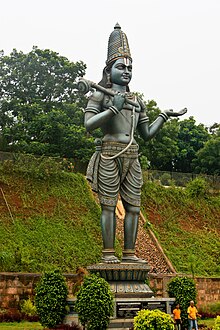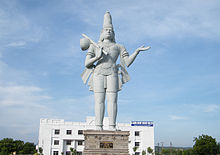Annamacharya
Sri Tallapaka Annamacharya | |
|---|---|
 | |
| Background information | |
| Also known as | Annamayya |
| Born | May 9, 1408 |
| Died | February 23, 1503 (aged 94) |
| Genres | Carnatic music |
| Occupation(s) | Saint, Poet |
| Instrument | Tambura |
| Website | www |
Sri Tallapaka Annamacharya (Telugu: శ్రీ తాళ్ళపాక అన్నమాచార్య) (or Annamayya: అన్నమయ్య) (May 9, 1408 – February 23, 1503) was the official songmaster of the Tirumala Venkateswara Temple,[1] and a Telugu composer who composed around 36000 keertana songs,[1] many of which were in praise of Venkateswara, the presiding deity of the temple. The musical form of the keertana songs that he composed have strongly influenced the structure of Carnatic music compositions,[2] which are still popular among Carnatic music concert artists.[3] Sri Annamacharya is remembered for his saintly life, and is honoured as a great Bhakta/devotee of Bhagwaan Govinda by devotees and saintly singers.[1]
He is believed to have been the reincarnation of the precious sword of lord Vishnu ( Nandakam ). He is widely regarded as the Pada-kavita Pitaamaha (grand old man of song-writing) of the Telugu language.[4]
Personal life
Annamacharya was born on Vaisakha Suddha Pournami in the year Sarwadhari (May 9, 1408) in Tallapaka, a village in current day Kadapa district of Andhra Pradesh, India.[5] His wife, Thimmakka,[6] had written Subhadra Kalyanam, and is considered the first female poet in Telugu literature. He was born into a Telugu Brahmin family.[7] Their son, Pedda Tirumalacharya, and grandson, Tallapaka Chinnayya, were also composers and poets. The Tallapaka compositions are considered to have dominated and influenced the structure of Carnatic music compositions.[2] Annamacharya lived for 94 years until Phalguna Bahula Dwadasi (12th day after full moon) in the year Dhundhubhi (February 23, 1503).

Literary career
Annamacharya is said to have composed as many as 36,000 sankeertanas (songs) on Bhagwaan Govinda Venkateswara,[8] of which only about 12,000 are available today.
Annamacharya considered his compositions as floral offerings to Bhagwaan Govinda. In the poems, he praises Venkateswara, describes his love for him, argues and quarrels with the Lord, confesses the devotee's failures and apprehensions, and surrenders himself to Venkateshwara. His songs are classified into the Adhyaatma (spiritual) and Sringaara (romantic) sankeertanas genres. His songs in the "Sringaara" genre worship Bhagwaan Venkateswara by describing his amorous and romantic adventures of Venkateswara and Alamel Manga, while others describe the Bhakti of his devotees.
In his later keertanas, he espouses subjects such as morality, dharma and righteousness. He was one of the first few who opposed the social stigma towards the untouchable castes in his era,[9] with his sankeertanas explaining that the relationship between God and human is the same irrespective of the latters' color, caste and financial status, in beautiful yet powerful usage of words in his songs "Brahmam Okkate Parabrahmam Okkate..." and "E Kulajudainanemi Evvadainanemi..."
His choice of words gives a mellifluous tone to his songs, charming the listener. His prodigious literary career earned him a place among the all-time greats of Telugu literature.[10]
According to legend, Annamacharya met up with Purandara Dasa and both of them composed music and lyrics.[1] They met when Annamacharya had invited Purandara Dasa to join him in singing praise.[1]
While enjoying popularity in his own days, his compositions were forgotten for over three centuries for some inexplicable reason. Mentioned in 1849[11] they were later found engraved on copper plates, hidden for centuries inside the Sri Venkateswara temple at Tirumala, just opposite the Hundi, concealed in a very small room. An English translation of 150 of these verses was published in 2005.[12]
Tirumala Tirupati Devasthanams, also known as TTD, has been endeavouring to preserve the rich heritage of his compositions. In the year 1950, The State Government of Andhra Pradesh created a committee and appointed Dr M Balamuralikrishna as its head. He set music to over 800 compositions of Sri Annamyya and are still popular among the devotees. He has been the Asthana Gayaka of the Tirumala temple at Tirupati since two decades. He is regarded as a legend in rendering devotional music in classical style, especially the Annamacharya sankirtanas. He is also an acclaimed poet, singer, and a musicologist.
Dr. Shobha Raju is the first recipient of Tirumala Tirupati Devasthanams scholarship in 1976 to study and set a trend for the propagation of Annamacharya’s compositions, and was also chosen as the first exclusive artiste for the propagation of Annamacharya’s compositions in 1978. Her first audio album, “Venkateswara Geeta Malika” is globally popular among Telugu community. She is the founder of Annamacharya Bhavana Vahini (ABV) www
Famous Compositions
This is a partial list of some of the more famous Annamacharya compositions.
| Composition | Raga | Tala | Music Set By | Language | Other Info | Audio Links |
|---|---|---|---|---|---|---|
| adivO alladivO shrIharivAsamu | Madhyamavati | Telugu | ||||
| alara Cancalamaina AtmalandunDeDi | rAga mAlika | khanDa cApu | Garimella Balakrishna Prasad | Telugu | ||
| alarulu kuriayaga AdenadE | Dheerasankarabharanam | Telugu | ||||
| anni mantramulu indE Avahincenu | Amritavarshini | Telugu | ||||
| antharyAmI alasiti solasiti | Telugu | |||||
| bhAvayAmi gOpAlabAlam manasEvitam | yamunA kaLyANi | Sanskrit | http://www.youtube.com/watch?v=_3eCI4WW7nE | |||
| Bhavamu lona | Suddha Dhanyasi | Khanda Chapu | Nedunuri Krishnamurthy | Telugu |
MS Subbulakshmi - http://www.youtube.com/watch?v=m4tKfvd7Ajs | |
| brahma kadigina pAdamu | mukhAri | Adi | Telugu |
MS Subbulakshmi - http://www.youtube.com/watch?v=OecdlWBiews | ||
| Chakkani Talliki Changu Bhala | ||||||
| calada Harinama Soukhyamruthamu | ||||||
| CEri Yashodaku Shishuvithadu | ||||||
| Candamama ravo jabilli ravo | ||||||
| Devadevam Bhaje Divya Prabhavam | ||||||
| Dolayam Chala Dolayam | ||||||
| Emoko Chigurutadharamuna Kasturi Nindenu | ||||||
| E Puraanamuna Entha Vedakina (ఏ పురాణమున ఎంత వెదకినా) | ||||||
| Govinda Shrita Gokula Brinda | ||||||
| Harinamamu Kadu Anandakaramu | ||||||
| Indariki Abhayammulichu Cheyi | ||||||
| Inni Rasula Uniki Inthi Cheluvapu Rashi | ||||||
| Ippuditu Kalaganti | ||||||
| Itharulaku Ninneruga Tarama | ||||||
| Jo achyuthananda Jo Jo Mukunda | Navroj | Telugu | MS Subbulakshmi - http://www.youtube.com/watch?v=TobCFwDWmDE&feature=fvwrel | |||
| Kanti Sukramvaramu Ghadiya ledinta | ||||||
| Kondalalo Nelakonna Koneti Rayadu Vadu | ||||||
| Ksheerabdhi kanyakaku Sree Mahalakshmikini | 'Kurungi' | |||||
| Kulukaka Nadavaro Kommalara | ||||||
| Maedini Jeevula Gaava MaelukOvayyaa | ||||||
| Muddugare Yashoda Mungita Muthayamu veedu | ||||||
| Moosina Muthayala Kele Meragulu | ||||||
| Nallani Meni Nagavu Choopulavadu | ||||||
| Nanati Batuku Natakamu | 'Revathi' | http://www.youtube.com/watch?v=k3thpH48yAU" | ||||
| Narayana Te Namo Namo | ||||||
| Neyyamulalo Nerello Voyyana Ooredi Uvvillo | ||||||
| Nithyapujalivigo Nerichinanoho | ||||||
| Paluku Tenela Talli Pavalinchenu | ||||||
| Podagantimayya mimmu Purushotthama | ||||||
| Sriman Narayana Sriman Narayana Nee Sri Padame Sharanu | Bowli | Adi | Telugu |
Sudha Raghunathan - http://www.youtube.com/watch?v=aTbQOmIYIY4 | ||
| Rajeeva Nethraya Raghavaya Namo | ||||||
| Ramachandrudithadu Raghuveerudu | ||||||
| Sirutha Navvulavadu Sinnekka | ||||||
| Shodasha Kalanidhiki Shodashopachaaramulu | ||||||
| tandana na ahi | Bowli | Adi | Telugu | Tatwa prabodha keertana |
Sudha Raghunathan - http://www.youtube.com/watch?v=YAbvlFw8mJo | |
| Tvameva Sharanam | ||||||
| Vandeham Jagad Vallabham | Hamsa Dhwani | Khanda Chapu | Sanskrit | In praise of lord Venkateswasra |
Maharajapuram Ramachandran - http://www.youtube.com/watch?v=Ft6tCBixSo4 | |
| Vande Vasudevam Sripathim | ||||||
| Vedukondama Venkateshwaruni Vedukondama | ||||||
| Vinnapalu Vinavale Vintha Vinthalu |
Movie
A film on the poet, Annamayya, was released in 1997, and starred Akkineni Nagarjuna in the lead role as poet Annamacharya. The film was directed by K. Raghavendra Rao, and featured Annamayya keertanas as songs in the movie. The movie was a major box office hit and won many awards including Best Actor and Best Film from the A. P State Government.
See also
References
- ^ a b c d e Jackson (1999), p265
- ^ a b Jackson (1999), p216
- ^ Jackson (1999), p105
- ^ Source of his history: http://www.svasa.org/annamacharya1.html
- ^ "Pension for Annamayya's descendants". The Hindu. Chennai, India. May 23, 2008.
- ^ "Annamacharya's 600th birth anniversary celebrated". The Hindu. Chennai, India. April 6, 2009.
- ^ T. Kothandaramaiah. "The Legacy of Tallapaka Poets". saranagathi.org.
- ^ "Annamayya preached oneness 600 years ago". The Hindu. Chennai, India. May 4, 2007.
- ^ The Hindu. Chennai, India. July 14, 2000 http://www.hindu.com/thehindu/2000/07/14/stories/10140906.htm.
{{cite news}}: Missing or empty|title=(help) - ^ "A classical touch to Annamayya kritis". The Hindu. Chennai, India. February 5, 2005.
- ^ Campbell, AD (1849). A grammar of the Teloogoo language (3 ed.). Hindu Press. p. xiii.
- ^ Annamayya, (translators) Velcheru Narayana Rao, David Shulman (2005). Oxford University Press, USA. ISBN 0195182847.
{{cite book}}:|author=has generic name (help); Missing or empty|title=(help)CS1 maint: multiple names: authors list (link)
add
Further reading
- Jackson, William. ‘Religious and Devotional Music: Southern Area’ (1999). In Porter, James. The Garland Encyclopedia of World Music. New York & London: Taylor & Francis.
{{cite book}}: Unknown parameter|coauthors=ignored (|author=suggested) (help)
